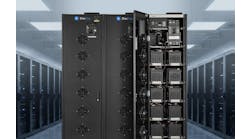Reports: Quest for Power, Land Banking, Submarket Migration Defines Current Data Center Trends
Assessing the industry's landscape over the second half of last year, JLL's North America Data Center Report | H2 2023 finds that accelerating demand for data center capacity, combined with a lack of power capacity, has led to "extremely limited availability with more preleasing" within North American facilities.
JLL said that "preleasing will continue to accelerate, as construction and power delivery timelines are not likely to decelerate over the next 12 months." The report affirms that within the data center industry, "power is the key hurdle, impacting all of the fundamentals."
As reckoned by the commercial real estate services firm, along with demand and availability, such fundamental industry concerns also encompass the areas of data center construction and operational rates.
Demand and Availability
JLL reports that in the second half of last year, North American data center demand, as measured in megawatts (MW) of power leased by users, continued to accelerate, with leasing activity in primary markets occurring mainly in data center projects under development, rather than across existing inventory. The report saw the primary North American data center markets signing 3.4 gigawatts (GW) of transactions in H2 2023, with total transactions for the year amounting to a record 4.3 GW.
Interestingly, the report states that "due to record demand in Northern Virginia, secondary markets declined significantly in share of overall demand." According to JLL, secondary markets added 124 MW of absorption in H2 2023 and 554 MW for the year. Meanwhile, the report found that in 2023, Northern Virginia, the largest data center market, led all markets with 1.6 GW of transaction volume "with deliveries anticipated in the next few years based on power availability."
The report adds, "Secondary markets have been growing in share of leasing activity over the last two to three years, as these markets can be more cost-effective and have shorter power-delivery timelines. However, in H2 2023, overwhelming leasing in Northern Virginia and Phoenix for product still under construction or proposed propelled primary markets to a total three times that of H1 2023."
In terms of demand drivers over the second half of last year, new impetus from generative AI unsurprisingly topped the list, followed closely by cloud and hyperscale concerns, and proximity to interconnection points.
Owing to the area's glut of financial services firms and local networks of AI talent, JLL reports that "New York and New Jersey saw significant AI deployments in H2 2023, with over 15 MW preleased in Orangeburg, NY and over 35 MW deployed for AI in New Jersey." Meanwhile, the report assessed that the dominance of cloud and hyperscale demand in the larger markets is "making it more difficult for smaller enterprise users to find colocation space and power to meet their needs."
JLL notes that this dynamic is causing some enterprise users to evaluate the shift from enterprise to cloud in light of rising costs, latency and information security concerns, while moving toward a “distributed cloud” of oursourced enterprise data center operations.
The new report concludes that in North America, "data center demand shows no sign of abating, but power availability and delivery timelines continue to dampen absorption." In response to these challenges, JLL advises, "Users must plan further ahead with their IT strategy and commit to space and power on accelerated timelines to find capacity to fit their requirements."
Data Center Construction
JLL's North America Data Center Report | H2 2023 saw data center construction racing to keep up with demand, with capacity under construction in primary and secondary markets exceeding 5.3 GW.
The report noted that rising demand and limited capacity have boosted construction in secondary markets, which account for almost 20% of capacity being built. "Because of power delivery timelines, most of the capacity coming online in 2024 is already preleased," states the report, while noting that "significant amounts of unleased capacity are two-plus years out in most primary markets."
Markets forecasted to multiply capacity per their current construction pipeline include Atlanta and Salt Lake City. According to JLL, "Salt Lake City is experiencing the fastest acceleration in construction, with more than twice as much capacity under construction as is currently existing."
Apart from new construction, the report duly discerns new data center capacity coming online through upgrades to existing data centers, and expansion in both horizontal and vertical directions. JLL notes that "upgrades in existing power infrastructure or onsite power generation can also add capacity, making data centers denser in MW per square foot."
Critically, the new report finds that "developers and enterprises are realizing their existing Basis of Design (BoD) does not support AI’s voracious power demands, which can be 2-4 times denser per cabinet than traditional enterprise deployments." The report observes how, once cabinet density exceeds approximately 50 kW per cabinet, traditional air-cooling technologies must cede to alternative methods such as the various liquid cooling technologies, which may produce disruptive change within data center design and operations.
Notwithstanding, the study finds colocation providers rapidly upgrading their infrastructure to meet burgeoning AI demand from enterprises, with hyperscalers also growing their footprints of AI-ready data centers, the better to sell those services to end users, as driven by highly efficient GPU designs. Further, the study discerns how, over the past five years, deep-pocketed investors have employed time-tested data center campus design strategies to enable gradual building of capacity, as a way of making construction more efficient and deploying funding over time.
In a world where new campus announcements routinely exceed 100MW, JLL points out how megacampus developments chasing AI capacity ranging from 300 to as high as 500 MW are putting even greater focus on power, causing users and developers to evaluate moving into more remote areas in secondary or tertiary markets.
Finally, the report cites recent design developments in multistory data centers and microgrids as promising prospects for shoring up gaps in data center capacity and power as the AI boom rolls on.
Operational Rates
JLL's North America Data Center Report | H2 2023 found the cost of operations rising along with growing rent and power costs. The report said that rental rates in primary markets rose fastest for small requirements as space became more constrained.
According to JLL, "Due to strong demand, rates nationally have risen 5% for small requirements under 250 kw and 11% for large requirements of 5 MW+ from H1 2023 to H2 2023." The report noted further, "Prices rose highest in markets with rapidly diminishing availability—Phoenix saw rates rise 17% to 30% (depending on capacity tranche) and in Northern California rates rose 21% to 23%. Rapid inflation also pushed annual rent escalations to increase to 4% to 5%," added the study.
JLL noted that the rental rate discount for larger users of data centers is significant. "On average rates were 18% lower for requirements above 5 MW than for requirements under 250 kW," said the report.
The commercial real estate services firm said the rate of rent growth should ease in some markets by late this year or early 2025 "as new capacity is added and supply chain bottlenecks continue to abate." Nonetheless, owing to power constraints and increasing demand, the firm warns that "landlords have power to raise rates, and in tight markets, rent could rise an additional 10% over the next year."
Meanwhile, JLL found that from 2022 to 2023, to go along with increased infrastructure investment, average power rates increased in all tracked primary and secondary data center markets (with Northern Virginia’s rates jumping 34%).
The report determined that primary markets saw the greatest increase in power rates, at 15.6% on average, compared with 9.0% in secondary markets.
A Hawk's Eye View
For its part in surveying the same landscape, DatacenterHawk's 4Q 2023 Data Center Market Recap noted how last year, "four markets in North America accounted for over 80% of the absorption that took place."
The study saw Northern Virginia accounting for nearly a third (33.1%) of this mass, followed by Atlanta (19%), Phoenix (15.8%), and Dallas/Fort Worth (12.7%).
DatacenterHawk discerned over 1.4 GW of absorption in major markets in 4Q 2023, with 601.3 MW of absorption in Northern Virginia alone, representing the region’s largest leasing quarter ever.
Other notable North American data center industry trends for the fourth quarter per the recap included continued land banking and migration to sub-markets.
The study saw hyperscalers securing 6,400+ acres of land in 4Q 2023. Meanwhile, secondary markets cited with having the most absorption in 4Q 2023 included:
- Salt Lake City (121 MW)
- San Antonio (90 MW)
- Columbus, Ohio (24 MW)
- Northern New Jersey (20.3 MW)
According to the report, other North American markets on track to gain momentum this year include Reno, Charlotte, Miami, Austin, Denver, along with Midwest sites cropping up in Indiana and Iowa.
DatacenterHawk's Luke Smith concluded, "With affordable land, a path to power, and a growing presence by cloud providers, these markets will allow colocation providers to grow their footprints in underserved data center regions, while utilities in more established primary markets continue to work towards sustainable power planning to meet increased energy demands."

Matt Vincent
A B2B technology journalist and editor with more than two decades of experience, Matt Vincent is Editor in Chief of Data Center Frontier.





